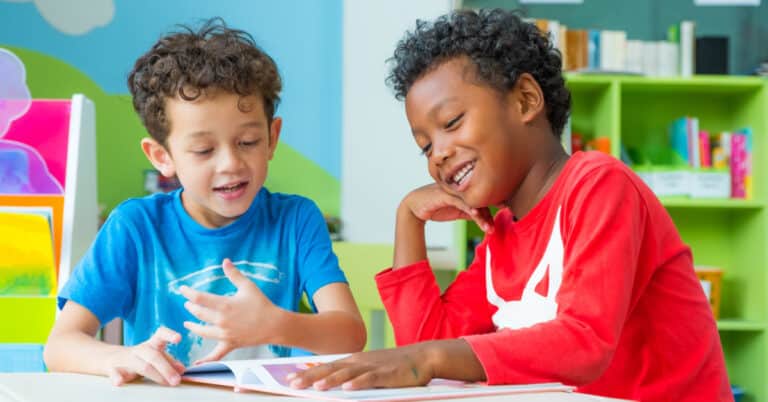
Personalized, competency-based learning centers each students’ strengths, needs and interests and provides differentiated supports and ways to demonstrate what they know and know how to do, ensuring each learner graduates ready for what’s next.
Teachers, parents, community members and students have questions about what personalized, competency-based learning will look like, and how it will impact the classroom experience and outcomes upon graduation. These answers to frequently asked questions could spark critical conversations about what personalized, competency-based learning offers your community.
Why is personalized, competency-based learning important for today’s students?
The way teachers teach and students learn is already changing – and KnowledgeWorks is partnering with learning communities across the country to ensure those changes are equitable and sustainable. Personalized, competency-based learning emphasizes creating engaging educational experiences that are customized to each learner’s strengths, needs and interests. Students have voice and ownership over how, what, when and where they learn and connections to community and real-world experiences are a priority.
What role does the teacher play in a personalized, competency-based classroom?
Relationships drive student learning. Teachers are essential, creating unique opportunities for learning, working with students to create classroom culture, helping students discover their learning needs and working side-by-side with learners throughout the year.
What is the role of technology in personalized learning?
Technology enables learning – but it isn’t central to the design of how we meet students’ needs. At the center of strong, effective teaching and learning is the relationship between a student and a teacher. And technology can’t replace that. Technology is a tool that can be used to support student activities and to meet each student where they are by providing engaging instruction, just-in-time supports and key real-world learning opportunities.
What is the role of state standards in a personalized, competency-based learning environment?
Standards guarantee every student an equal, quality education. In states committed to scaling personalized, competency-based learning, standards are about more consistency. They’re aligned to competencies that allow students to demonstrate what they know and know how to do – ensuring high quality, meaningful learning experiences for students from all tax bases and zip codes.
How is personalized, competency-based education integrated into career-based learning pathways?
Students connect their learning with life beyond the classroom. Certifications through career and technical education (CTE) opportunities are great examples of how school districts can implement personalized, competency-based learning for career readiness. Students participating in certification programs, such as Certified Nursing Assistant programs or welding programs, are required to show competency in a number of areas before they are certified in their field. CTE programs build upon earlier learning in the classroom and ensure learning is relevant and transferable for students in ways that directly benefit their career trajectory.
What does it mean for students to work at their own pace?
Students move ahead when they have demonstrated mastery of content, not when they’ve reached a point in the school year. In a personalized, competency-based learning environment, a class pace is set by the teacher based on where each student excels and requires support. Students are aware of how what they’re working on contributes to their understanding of the learning targets, and what they need to do to show what they’ve learned and at what level of rigor. There may be some learners who work faster or a little slower, but this more student-centered approach gives the teacher greater understanding as to where each student is, and when supports are needed to advance deeper learning in ways that are empowering and motivating to each learner.
How will a teacher personalized learning for every single student?
A learner-centered classroom doesn’t mean 25-30 individual lesson plans for each student. It’s about developing a student’s agency so they have a voice in their education, choices in how they learn and present that knowledge to others and engagement opportunities to access content in the best way for them. The school day includes instructional time with the teacher and opportunities to work independently, in pairs or with other students. Because their learning targets are transparent, students work with the teacher to determine what they need to accomplish to meet them and how they could show evidence of learning. Learning isn’t a mystery, and students have a greater understanding of what they need to learn and why.
Are students tracked in a personalized, competency-based learning environment?
Tracking – the widespread practice of labeling, ranking, sorting and separating students by perceived academic ability and behavioral compliance – limits what learners have access to and can achieve. Once tracked, students typically receive very different expectations, messages, learning conditions, peer cohorts, teachers, pedagogies, curricula and opportunities. And over time, those differences open more and more doors for some while slamming them shut for others.
But in a personalized, competency-based learning environment, students learn actively using different pathways and varied pacing that does not result in tracking or other forms of ability grouping. Each of the core elements of personalized, competency-based education – engaging experiences, a focus on the learner’s individual needs and assets, student agency and autonomy, connections to real-world experiences and preparation – have a substantial body of research and evidence supporting their efficacy in closing opportunity gaps and producing more equitable outcomes.
What does a transcript from a personalized, competency-based education environment look like?
In a personalized, competency-based system, there are clearly defined expectations for what mastery looks like for each learning target. This helps to ensure that all students are held to the same high standard and given the support they need to succeed at the highest levels. To see how a competency-based transcript functions, download these images or contact Mastery Transcript Consortium (MTC) for an interactive version. MTC is a national nonprofit membership organization that helps make mastery learning – or competency-based education – available to all learners. Because this approach does not generate traditional metrics, we co-create uniquely flexible and scalable learning records to solve the challenge of credentialing. MTC accelerates equitable access to and widespread implementation of mastery learning models, empowering students to showcase competencies and share evidence of their learning.
Download a PDF version of this page.




